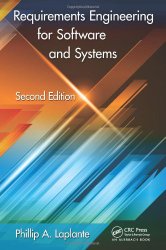Engineering Bookshelf
- Aerospace
- Biological
- Civil
- Chemical
- Environmental
- Electrical
- Materials
- Mechanical
- Petroleum
- Geoengineering
- Software

Requirements Engineering for Software and Systems
by Phillip A. LaplantePublisher: Auerbach Publications
ISBN: 1466560819
Check price @ amazon.com , amazon.ca , amazon.co.uk
Book Description
As requirements engineering continues to be recognized as the key to on-time and on-budget delivery of software and systems projects, many engineering programs have made requirements engineering mandatory in their curriculum. In addition, the wealth of new software tools that have recently emerged is empowering practicing engineers to improve their requirements engineering habits. However, these tools are not easy to use without appropriate training.
Filling this need, Requirements Engineering for Software and Systems, Second Edition has been vastly updated and expanded to include about 30 percent new material. In addition to new exercises and updated references in every chapter, this edition updates all chapters with the latest applied research and industry practices. It also presents new material derived from the experiences of professors who have used the text in their classrooms. Improvements to this edition include:
- An expanded introductory chapter with extensive discussions on requirements analysis, agreement, and consolidation
- An expanded chapter on requirements engineering for Agile methodologies
- An expanded chapter on formal methods with new examples
- An expanded section on requirements traceability
- An updated and expanded section on requirements engineering tools
- New exercises including ones suitable for research projects
Following in the footsteps of its bestselling predecessor, the text illustrates key ideas associated with requirements engineering using extensive case studies and three common example systems: an airline baggage handling system, a point-of-sale system for a large pet store chain, and a system for a smart home. This edition also includes an example of a wet well pumping system for a wastewater treatment station.
With a focus on software-intensive systems, but highly applicable to non-software systems, this text provides a probing and comprehensive review of recent developments in requirements engineering in high integrity systems.
About the Author
Phillip A. Laplante, PhD, is professor of software engineering and a member of the graduate faculty at The Pennsylvania State University (Penn State). His research, teaching, and consulting focuses on software quality, particularly with respect to requirements, testing, and project management. Before joining Penn State he was a professor and senior academic administrator at several colleges and universities.
Dr. Laplante has consulted to Fortune 500 companies, small businesses, the US DOD, and NASA. He has also served on the technology advisory boards for several companies. Prior to his academic career, Dr. Laplante spent nearly a decade as a software engineer and project manager working on avionics (including the Space Shuttle), CAD, and software test systems. He was also director of business development for a software consulting firm. He has authored or edited 29 books and more than 200 papers, articles, reviews, and editorials.
Dr. Laplante received his BS, MEng, and PhD in computer science, electrical engineering, and computer science, respectively, from Stevens Institute of Technology and an MBA from the University of Colorado at Colorado Springs. He is licensed in Pennsylvania as a professional engineer and is a Certified Software Development Professional. He is a fellow of the IEEE and SPIE and a member of numerous professional societies, program committees, and boards.
Customer Reviews
By dan silber
Surprisingly palatable read with a topic that can easily be quite dry. They use scenarios and examples to make the content relatable.
The content is quite good, giving some examples of how requirements elicitation goes in real life: dealing with conflicting requests, non-functional requirements, and incomplete information.
By Ben Amaba
This is a great reference with its compilation of key aspects of requirements engineering and its importance in the systems of today. It is a quick read and has a list of key excerpts that we need to be reminded of and apply more frequently. The narratives remind the reader of why requirements engineering is critical and illustrate the impact the discipline has. Informal and formal methods are summarized well. The example of a Smart Home is a good example showing the ideas presented in the text. We look forward to the second edition due this Fall 2013.